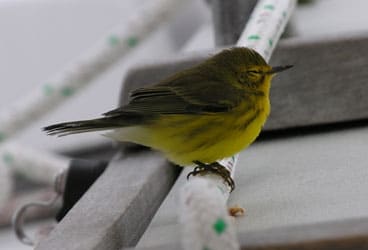
Bird368
In her story “Bird, Interrupted,” Wendy Mitman Clarke describes an unfamiliar bird that landed on Osprey during a recent passage from Block Island to Cape May, New Jersey. To identify the winged wanderer, CW copy editor John Wilson contacted former CW associate editor Nim Marsh, a noted birder, outdoorsman, and small-boat sailor:
Wilson: We turn to you, Nim, in our hour of need. Can you ID this feller for us? The bird landed on a boat about 10 hours out from Block Island heading for Cape May. Thanks!
Marsh: OK, this could have been a rather serendipitous avian visit, for I believe the bird’s genus is Wilsonia (of all things); its species canadensis. In English: Canada Warbler. Its narrow bill earmarks it as a warbler. Its muted black “necklace” indicates an adult male in nonbreeding plumage. (When breeding, the necklace would be darker and more distinct.) He also appears to have the white “undertail coverts” characteristic of the species. Even though the little guy is roughed up and tired, I can see the eye-ring around the eye and the little yellow stripe between eye and bill-both diagnostic details of the bird. He’s all puffed out so that he can stay warm. Cape May, in a more normal year temperature-wise, is well within the migratory route of the species at this time of year.
Thanks for sending this along. Can you believe Wilsonia?
Following the above exchange, Wilson discovered that the bird’s genus was named to commemorate the Scottish-born American poet and ornithologist Alexander Wilson. Go here (en.wikipedia.org/wiki/Alexander_Wilson) and here (xroads.virginia.edu/~PUBLIC/wilson/front.html) for additional information on this 18th-century Enlightenment figure.








